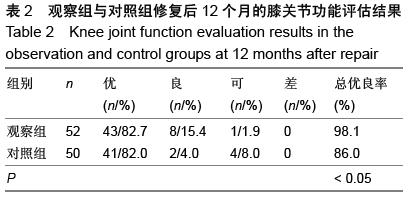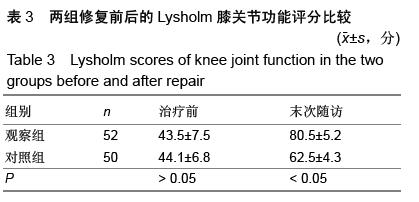| [1] 杨青,刘洋.可吸收螺钉内固定法治疗髌骨横断骨折[J].生物骨科材料与临床研究,2005,2(1):49-50.
[2] 方苏亭,刘国辉,何勇,等.可吸收螺钉在髌骨横断骨折中的应用[J].中国中医骨伤科杂志,2006,14(3):44-44.
[3] Springorum HP,Siewe J,Dargel J,et al.Classification and treatment of patella fractures. Orthopade. 2011;40 (10): 877-884.
[4] 刘国辉,杨述华,杜靖远,等.可吸收螺钉与克氏针张力带治疗髌骨骨折应用选择比较[J].中国矫形外科杂志, 2007, 15(14): 1059-1061,1068.
[5] 杨波,万盛钰,吕玉明,等.Takiron可吸收螺钉与改良式张力带治疗髌骨骨折的疗效比较[J].广东医学, 2013,34(8): 1200-1202.
[6] Wild M,Windolf J,Flohé S.Fractures of the patella. Unfallchirurg.2010;113(5):401-411.
[7] 李锋,王来喜,赵启,等.经皮可吸收螺钉内固定治疗髌骨纵形骨折[J].现代中西医结合杂志, 2008,17(13):2013-2014.
[8] 肖军,杨述华,许伟华,等.国产超高分子聚乳酸可吸收螺钉治疗髌骨骨折术后下肢功能评定半年随访[J].中国临床康复, 2005,9(42):60-62.
[9] 李良,李海波,陈运庆,等.可吸收带线锚钉治疗髌骨上下极撕脱性骨折22例[J].中国骨与关节损伤杂志, 2014, 29(1): 75-76.
[10] 张继业,王新,杨琳,等.可吸收螺钉张力带固定横行髌骨骨折的生物力学研究[J].实用骨科杂志, 2014,20(12): 1100-1103.
[11] Vidal C,Guing O,de Thomasson E,et al.Painful patellofemoral instability secondary to peroperative patellar fracture during bone-patellar tendon-bone autograft harvesting for anterior cruciate ligament reconstruction.Orthop Traumatol Surg Res. 2012; 98(6):666-669.
[12] 任平,陈晓艺,姚海波,等.可吸收螺钉与AO张力带内固定治疗髌骨骨折的疗效比较[J].中国骨与关节损伤杂志, 2012,27(4):344-345.
[13] 赵磊,王黎明,蒋纯志,等.新型内固定材料可吸收螺钉治疗髌骨骨折的应用特点[J].中国组织工程研究与临床康复, 2007,11(1):175,177,插2.
[14] 王亦璁,姜保国.骨与关节损伤[M].4版.北京:人民卫生出版社, 2009:1385-1386.
[15] 刘国辉,杨述华,杜靖远,等.可吸收螺钉与克氏针张力带治疗髌骨骨折比较[C].//全国骨关节与风湿病暨第三届武汉国际骨科高峰论坛论文集,2012:225-226.
[16] 赵家鹏,李长树,孙雷,等.FIXSORB可吸收螺钉治疗髌骨骨折33例[J].创伤外科杂志,2014,16(4):333-335.
[17] 王凤彦.可吸收螺钉与克氏针张力带治疗髌骨骨折的对比分析[J].中国继续医学教育, 2015,7(14):118-119.
[18] 陈小磊,谭加群,李建赤,等.可吸收内固定材料治疗髌骨骨折的临床研究[J].中华关节外科杂志(电子版), 2013, 7(5): 679-682.
[19] 梁永新,金亮,赵晋平,等.带线锚钉内固定结合可吸收钉在髌骨粉碎性骨折中的应用[J].新疆医学, 2015,45(1):54-56.
[20] Vidovi? D,Matejci? A,Ivica M,et al.Approach to distal femur by osteotomy of the patellar distal pole and internal fixation with basket plate in complex articular fracture: report of five cases.Acta clinica Croatica. 2013;52(1):113-118.
[21] 徐可林,殷渠东,顾三军,等.可吸收螺钉固定的并发症及预防[J].中国组织工程研究,2013,17(9):1605-1610.
[22] Baombe JP.Towards evidence-based emergency medicine: best BETs from the Manchester Royal Infirmary. BET 4. Cylinder plaster versus cricket pad splint in uncomplicated patellar fractures.Emerg Med J.2011;28(2):168-168.
[23] 张彦东,邓磊,马占忠,等.可吸收钉张力带固定和AO张力带内固定治疗老年髌骨骨折的疗效比较研究[J].中国骨与关节损伤杂志, 2010,25(3):252-253.
[24] Lazaro LE,Wellman DS,Klinger CE,et al.Quantitative and qualitative assessment of bone perfusion and arterial contributions in a patellar fracture model using gadolinium-enhanced magnetic resonance imaging: a cadaveric study.J Bone Joint Surg Am. 2013;95(19): e1401-1407.
[25] 崔操,郭一行,李厚成,等.关节镜下利用可吸收螺钉和orthocord线治疗前交叉韧带止点撕脱性骨折的临床观察[J].海军医学杂志,2014,35(4):291-293.
[26] Traa WA,Oomen PJ,den Hamer A,et al. Biomechanical studies on transverse olecranon and patellar fractures: a systematic review with the development of a new scoring method.Br Med Bull. 2013;108:131-157.
[27] 王仁,齐东海,许向东,等.切开复位可吸收螺钉和重建钢板内固定治疗Pipkin Ⅳ型骨折[J].中华创伤骨科杂志, 2013, 15(8): 722-723.
[28] 岳凯,李棋,李箭,等.可吸收空心螺钉与爱惜邦线结合新型张力带固定与改良张力带固定治疗髌骨骨折的方法及疗效比较研究[C].//四川省医学会第十四次骨科学术会议论文集, 2010:296-296.
[29] 喜占荣,布林,李淑芳,等.可吸收钉联合可吸收线与空心钉张力带内固定治疗髌骨骨折的疗效比较[J].中国骨与关节损伤杂志, 2014,29(12):1261-1262.
[30] 崔海峰.可调式髌骨爪结合可吸收线与克氏针钢丝张力带修复粉碎性髌骨骨折的比较[J].中国组织工程研究, 2015,19(22):3555-3559.
[31] Stocker RL,Macheiner A.Fracture of the patella in a young upcoming sportsman due to distraction injury, occurring after a healed distraction fracture or a traumatized bipartite patella: Response to: A concern regarding the diagnosis of injury of a bipartite patella at the lower part of the patella.Arch Orthop Trauma Surg. 2014;134(1):145-147.
[32] 李先启,王书沛,燕志远,等.可吸收内固定装置结合术后铰链支具治疗髌骨骨软骨骨折[J].中华临床医师杂志(电子版), 2012,6(22):7451-7452.
[33] Chen CH,Huang HY,Wu T,et al.Transosseous suturing of patellar fractures with braided polyester - A prospective cohort with a matched historical control study.I njury.2013;44(10):1309-1313.
[34] Muzaffar N,Ahmad N,Ahmad A,et al.The chopstick-noodle twist: An easy technique of percutaneous patellar fixation in minimally displaced patellar fractures.Trop Doct.2012;42(1):25-27.
[35] 阮良峰,马俭凡,陈源,等.髌骨针+Polysorb可吸收线缝扎固定治疗髌骨粉碎性骨折的疗效分析[J].临床合理用药杂志,2013,6(23):18-20.
[36] Zampini JM.CORR Insights®: Association of a modified frailty index with mortality after femoral neck fracture in patients aged 60 years and older.Clin Orthop Relat Res. 2014;472(3):1018-1019.
[37] 郑金龙,王以进,陈爱民,等.可吸收内固定材料植入髌骨横断性骨折局部:与金属植入物生物力学性能的比较[J].中国组织工程研究与临床康复,2009,13(51):10069-10073.
[38] 许凌云,邵立尧.聚髌器联合可吸收缝线或克氏针治疗63例髌骨粉碎性骨折的临床分析[J].健康必读(下旬刊), 2012,14(11):23-23.
[39] Konda SR,Dayan A,Egol KA.Progressive migration of broken Kirschner wire into the proximal tibia following tension-band wiring technique of a patellar fracture--case report.Bull NYU Hosp Jt Dis.2012; 70(4): 279-282.
[40] 陈朝晖,郭军,成振江,等.双股钢丝与可吸收螺钉内固定治疗髌骨骨折的临床比较[J].中外医疗,2013,32(22):13-14.
[41] Goto K,Okuzu Y,So K,et al.Clinical and radiographic evaluation of cemented socket fixation concomitant to acetabular bone grafting fixed with absorbable hydroxyapatite-poly-l-lactide composite screws.J Orthop Sci.2016;21(1):57-62.
[42] Brunner S,Vavken P,Kilger R,et al.Absorbable and non-absorbable suture fixation results in similar outcomes for tibial eminence fractures in children and adolescents.Knee Surg Sports Traumatol Arthrosc. 2016;24(3):723-729.
[43] Arama Y,Salmon LJ,Sri-Ram K,et al.Bioabsorbable Versus Titanium Screws in Anterior Cruciate Ligament Reconstruction Using Hamstring Autograft: A Prospective, Blinded, Randomized Controlled Trial With 5-Year Follow-up.Am J Sports Med.2015; 43(8): 1893-1901.
[44] Savolainen MJ,Ritvanen AG,Koljonen VS,et al.Mechanical Analysis of Ultrasound-Activated Pins and Resorbable Screws: Two Different Techniques to Fixate Osteosynthesis in Craniosynostosis Surgery.J Craniofac Surg.2015;26(4):1234-1237.
[45] Xie Y,Cai L,Deng Z,et al.Absorbable Screws Versus Metallic Screws for Distal Tibiofibular Syndesmosis Injuries: A Meta-Analysis.J Foot Ankle Surg.2015; 54(4):663-670.
[46] Mascarenhas R,Saltzman BM,Sayegh ET,et al.Bioabsorbable versus metallic interference screws in anterior cruciate ligament reconstruction: a systematic review of overlapping meta-analyses. Arthroscopy. 2015; 31(3):561-568.
[47] Kashima N,Shiramizu K,Nakamura Y,et al. Biomechanical comparison of the fixation after curved periacetabular osteotomy using titanium and bioabsorbable screws.Hip Int. 2015;25(2):164-167.
[48] Sun H,Li Q,Tang X,et al.[Effectiveness of mini incision and absorbable screw fixation for treatment of anterior cruciate ligament tibial eminence avulsion fracture].Zhongguo Xiu Fu Chong Jian Wai Ke Za Zhi.2014;28(9):1072-1076.
[49] Kubozono K,Takechi M,Ohta K,et al.Aesthetic recovery of alveolar atrophy following autogenous onlay bone grafting using interconnected porous hydroxyapatite ceramics (IP-CHA) and resorbable poly-L-lactic/ polyglycolic acid screws: case report.BMC Oral Health. 2014;14:60.
[50] Sun H,Luo CF,Zhong B,et al.A prospective, randomised trial comparing the use of absorbable and metallic screws in the fixation of distal tibiofibular syndesmosis injuries: mid-term follow-up.Bone Joint J. 2014;96-B(4):548-554. |
.jpg)




